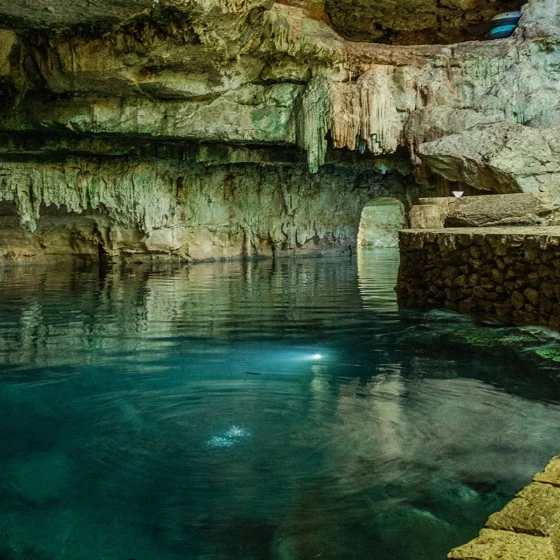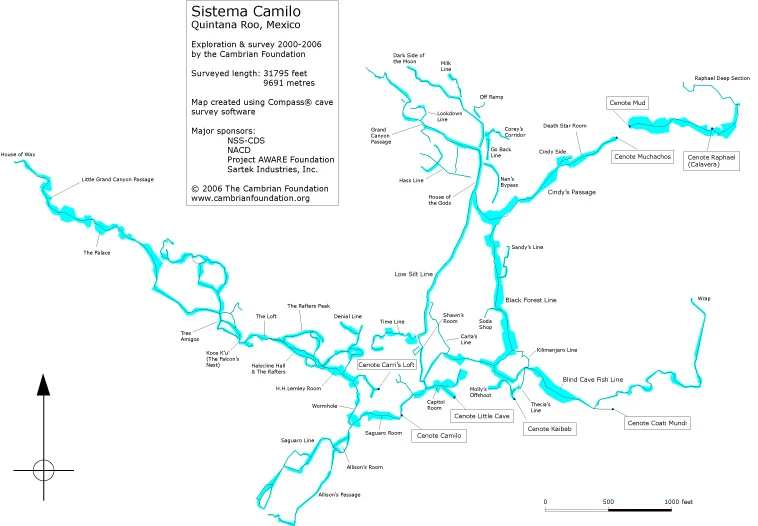Lost in Sistema Camilo: The Final Dive of Keith Price


| Incident location (country, town/region, cave name) | Diver full names |
|---|---|
| Mexico, Quintana Roo, Sistema Camilo (Cenote Muchachos) | Keith Price |
It was a calm Wednesday afternoon, 25 February 2015, in Quintana Roo when three experienced divers began their first dive of the trip.
Team members:
- Keith Price (72)
- Tom Corwin
- Bill Lavine
At approximately 1400 hours, the group entered Cenote Muchachos, one of the known entrances to the Sistema Camilo cave system. All three had many years of experience, were familiar with the cave, and carried full diving gear — diving masks, diving suits, tanks, and dive computers.
The Dive Progress
From data later recovered from Price’s dive computer, cave expert Bil Phillips reconstructed what happened.
- 35 minutes in: The divers were 1,800 feet deep into the cave.
- Depth: About 60 feet below the surface.
- They reached their gas turn-around pressure and decided to head back.
The group signaled to each other and began their slow exit, following the main guideline toward the cenote entrance.
The Moment of Separation
Somewhere during the start of the exit, visual contact with Keith Price was lost.
One diver later said:
“I thought I saw Keith’s light… but it was off to the right side of the guideline, deeper than where we were.”
This detail became important. Price appeared to have strayed from the route—possibly intentionally, possibly not.
The Short Search
The two remaining divers began a brief but urgent search:
- They backtracked along the line.
- They swept their lights across the water, searching for bubbles or movement.
- No sign of Price.
Gas levels were dropping, and they could not risk running out. The decision was made to exit the cave.
Surface Realization
At 1500 hours, the two surfaced at Cenote Muchachos.
They immediately asked one diver’s wife:
“Has Keith surfaced?”
Answer: “No.”
Panic began to set in. They informed the cenote caretakers that a diver was missing inside the cave.
Early Assumptions
By this time, the survivors feared two possibilities:
- Price had run out of air somewhere inside the cave.
- He had exited through another entrance.
First Search Effort
An underwater search team quickly entered the system:
- They checked the main guideline.
- They explored 150 feet down each side passage.
The only clue: a faint bubble trail leading deeper into the cave.
When that trail disappeared, the team had no direction to follow and ended the search for the day.
Land Search Attempts
Land-based teams checked other nearby cenote entrances.
No sign of Keith Price was found. The mystery deepened. The cave was silent, cold, and dark — and somewhere inside, an experienced diver had vanished.
The Second Day
Morning light filtered through the jungle canopy, but the shadows inside the cave system still felt endless.
The underwater search team entered the water again, checking their diving gear and making sure every diving computer was set for the dive ahead. Their mission was simple but grim — find the missing man.
Inside the flooded tunnels, they scanned the rock walls, watching for the smallest signs: disturbed silt, scratches, or stray bubbles. After several minutes, they spotted it again — a bubble trail drifting toward the surface in places where there was no obvious exit. It was faint, but it was a lead.
The Clues at Cenote Camillo
Following the bubbles brought them to Cenote Camillo, another remote entrance to Sistema Camilo.
On the stone edge of the cenote sat two diving tanks.
- Tank 1: 450 psi
- Tank 2: 500 psi
These readings told a story: Keith Price had reached this spot with air left in both cylinders, but not much.
A guideline stretched from the cenote and vanished into the thick jungle. The search divers called his name, their voices echoing in the cavern and fading into the trees. There was no reply — only the quiet hiss of their regulators.
They surfaced, exchanged quick looks, and decided to return to Cenote Muchachos to tell the surface team what they had found.
The Jungle Search
With the location confirmed, the surface team hiked to Cenote Camillo. The ground was soft in places, tangled with roots and vines, and the air was heavy with the smell of damp vegetation.
They picked up the guideline and began following it. About 200 feet in, they found the first personal items:
- A pair of fins, left neatly to one side.
- A diving helmet, its light still attached but turned off.
From here, the guideline ended. But Keith’s path was still visible — branches bent downward, fresh scrapes in the bark, plants crushed underfoot. It was as if he had been moving with urgency, trying to reach something.
The Final Discovery
The rescuers pressed on, tracking every sign. The jungle grew denser, making progress slow. They imagined what it must have been like for Keith — wearing a wetsuit, hood, buoyancy compensator, and a cave diving harness, carrying the weight of gear while moving through rough terrain in tropical heat.
Finally, more than 1,600 feet from the cenote, they saw him.
Keith Price was lying face down on the ground. He still had on his diving mask with prescription lenses, his lights, and his dive computer. The jungle had swallowed him in silence, and now the search was over.
Cause of Death
The body was brought back carefully for examination.
An autopsy revealed that a heart attack had taken his life. He had survived the cave, found a way out of the water, and begun his trek through the jungle — but his heart had failed before he could find help.
The Cave’s Cold Silence
The cenotes closed back over, their entrances still and dark. Inside Sistema Camilo, the water remained perfectly clear, as if nothing had happened.
It wasn’t the cave itself that had killed him, but the hidden dangers of exertion, isolation, and age. Still, for those who knew the story, the silence of the cave now carried an unshakable weight — as if it remembered.
Unanswered Questions
No one could say for certain why Keith Price separated from his group inside Sistema Camilo. He had been an experienced cave diver, yet at some point he began following an adjacent line that led away from his original point of entry.
This line had permanent arrows, but they pointed toward another section of the cave system — not toward safety.
The Wrong Turns
According to cave diver and investigator Bil Phillips, Price would eventually have realized that this guideline wasn’t leading him back to Cenote Muchachos. Along the way, he encountered several jump lines — smaller connections leading to other passages.
Instead of using a jump reel to maintain a continuous connection to the main guideline, Price followed one of these lines deeper. This second line also had markers pointing further inward.
It too came to an abrupt end.
The Visual Gaps
At that point, Price made another critical choice — he attempted a visual gap to another line, again without using a guideline.
In total, counting his original decision to leave the main route, he made three intentional visual gaps. Each time, he was moving without a guaranteed path back to his entry point. In cave diving, this is one of the most dangerous mistakes a diver can make.
By Pure Chance
By sheer luck, these wandering routes brought him to Cenote Camillo.
He surfaced there before running out of air in his diving tanks. But instead of waiting for rescue or trying to find another water route, he began moving overland, likely thinking he could return to his vehicle and the starting point.
The Final Factors
Phillips noted that Price was now dealing with a deadly combination:
- Physical exertion from hiking in full or partial diving gear
- Dehydration from the tropical heat
- Overheating inside a wetsuit and hood
The autopsy confirmed the final blow — a heart attack.
While the fatal moment happened in the jungle, Phillips concluded that the root cause was poor decision-making inside the cave. Each wrong turn, each lost connection to the main line, had placed him further from safety until there was no chance left.

